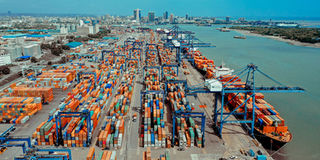How Tanzania’s strategic port is redefining regional logistics
Sponsored by Tanzania Ports Authority

A section of Dar es Salaam Port.
What you need to know:
- The $250 million investment by DP World, with potential to rise to $1 billion, is revolutionising Dar es Salaam Port’s efficiency and infrastructure, making it a central hub for East African trade.
- Uganda’s decision to route a significant portion of its petroleum imports through Dar es Salaam marks a strategic shift, highlighting the port’s growing appeal over traditional routes.
- With the African Continental Free Trade Area (AfCFTA) on the horizon, Dar es Salaam Port is poised to play a crucial role in boosting intra-African trade, solidifying its position as a gateway for the continent’s economic integration.
By Jasper Kwayu
The sun hungs low over the Indian Ocean, casting a molten gold shimmer across the surface as it slowly retreats into the abyss. From my perch atop a shipping container at Dar es Salaam Port, the world seems to slow down, if only for a moment.
The port, Africa’s beating heart of trade, is alive with the sound of cranes groaning under the weight of progress, ships docking like weary travellers from another dimension, and the murmur of deals brokered in a dozen languages. This is the frontline of East Africa’s economic war room, where strategy meets the sweat of the working man. And where, incidentally, the Tanzania Ports Authority (TPA) is poised to make its biggest moves yet.
“This isn’t just a port,” Plasduce Mbossa, the Director General of TPA, had said earlier in the day as we stood in the shadow of a colossal gantry crane. “Dar es Salaam is the gateway to East Africa, and what we’re doing here will redefine trade across the continent.” His voice carried the weight of someone who had long stopped dreaming and started doing.
In the simmering heat of the day, you can almost hear the quiet rumblings from across the border. Mombasa, Kenya’s stalwart port and once the undisputed king of East African trade routes, has to now reckon with stiffening competition. Dar es Salaam, the sleepy giant of the Indian Ocean, has woken up, and it’s hungry.
Dar es Salaam’s strategic position
Dar es Salaam Port, with its recent upgrades, stands as a testament to what can be achieved when vision meets investment. The port’s proximity to Southern and Central African markets like Zambia, Malawi, Burundi, Rwanda and DRC, gives it a competitive edge that Mombasa can no longer ignore. As these landlocked nations look for the fastest, most cost-effective routes to the sea, Dar es Salaam offers a solution that cuts down on transit times and logistics costs, making it an increasingly attractive option.
“Our proximity to these markets isn’t just geographic; it’s strategic,” Mbossa had said, as we watched a container ship being unloaded with a precision that was once thought impossible here. “Mombasa may be our closest rival, but our direct access to nations like Zambia, Malawi, Burundi, Rwanda and DRC puts us in a unique position to dominate trade in the region.”
Indeed, the numbers are telling. Malawi and Zambia have long depended on Beira in Mozambique, and to some extent Mombasa, for its exports. But with the improvements in Dar es Salaam Port, including the recent deepening of its berths to accommodate larger vessels, the tide is turning.
Burundi, Rwanda and DRC too, find Dar es Salaam’s new efficiency impossible to ignore. The port’s strategic upgrades have enabled it to handle more cargo in less time, with ship waiting times now reduced significantly from 28 days to less than a week. “It’s not just about speed,” Dr George Fasha, TPA’s Director of Marketing had said. “It’s about reliability. Shippers need to know that when they choose Dar es Salaam, they’re choosing consistency, and that’s exactly what we’re delivering.”
Uganda’s shift and the emerging Dar es Salaam corridor
In a move that signals the growing preference for Dar es Salaam, Uganda recently shifted a significant portion of its petroleum imports through this port. This decision, driven by the need to cut costs and improve efficiency, underscores a broader trend where countries traditionally reliant on Mombasa are reconsidering their options. The logic is simple. They are seeking faster, more reliable alternatives.
This shift is not just about Uganda; it’s about the entire East African region rethinking its logistics strategies. The Dar es Salaam Corridor is emerging as a viable, if not superior, route for goods destined for landlocked countries. And as DP World, a global prover of logistics solutions, continues its $250 million investment into the port, with plans to expand this to $1 billion, it’s clear that Dar es Salaam is positioning itself to be the go-to port for the entire region.
“We’re creating a corridor that makes economic sense,” Dr Fasha had continued, his voice crackling with the kind of excitement you don’t often hear in boardrooms. “The integration with our neighbours isn’t just good business; it’s the future of African trade.”
The energy in his words mirrored the buzz of activity all around us. The port was alive, not just with the movement of goods, but with the promise of something bigger – a vision of East Africa united not by borders, but by shared economic growth.

The DP World factor: Efficiency meets ambition
DP World’s involvement in Dar es Salaam is part of a broader, almost imperial ambition. Their 30-year concession to manage and upgrade the port isn’t just about building bigger infrastructure, but more about creating a seamless logistics ecosystem. With investments in temperature-controlled storage facilities for the agricultural sector and the integration of the port with Tanzania’s rail and road networks, DP World is betting on Dar es Salaam becoming the logistics hub of East Africa.
“We’re going to lower logistics costs and improve the ease of doing business in East Africa,” the DP World Tanzania Chief Executive Officer, Martin Jacob, had pointed out. “This is about creating value not just for Tanzania, but for the entire region.”
Indeed, the efficiencies brought by DP World are already making waves. Since they began operations, Dar es Salaam has seen a dramatic reduction in ship waiting times and the elimination of the $1,000 per container demurrage fee, which alone is expected to save Tanzania’s economy approximately $600 million annually.
“We’re not just playing catch-up with Mombasa,” Dr Fasha had pointed out with a smile that had said more than words ever could. “We’re setting the new standard.”
Mombasa’s heat
Mombasa is feeling the heat. The port, Kenya’s crown jewel, has faced congestion in recent times. This, in addition to higher logistics costs, are beginning to erode its dominance.
As Rwanda, Malawi, Zambia, Burundi, and even Uganda, start to pivot towards Dar es Salaam, Mombasa finds itself at a crossroads.
“Mombasa has its advantages, but it’s starting to feel the pressure,” Mbossa had said, referencing the fact that recent upgrades at Dar es Salaam Port had already begun to show dividends, with ship turnaround times reduced drastically.
The message is clear: Dar es Salaam Port is open for business, and it’s ready to take on all comers. The port isn’t just an alternative; it’s quickly becoming the preferred choice for many East African nations.
A vision for intra-African trade
Beyond the competition, there’s a bigger picture at play, one that involves not just East Africa but the entire continent. The African Continental Free Trade Area (AfCFTA) is poised to revolutionise intra-African trade, and ports like Dar es Salaam will be at the forefront of this transformation.
“We’re not just looking at East Africa; we’re looking at Africa as a whole,” Mbossa had said with a visionary’s gleam in his eye. “Dar es Salaam is going to be a key player in AfCFTA, providing a gateway for African nations to trade more easily with each other.”
This isn’t just talk. The port’s integration with the Standard Gauge Railway (SGR) and its connections to the Tanzanian hinterland are part of a broader strategy to facilitate the movement of goods across the continent. By reducing the cost and time of transportation, Dar es Salaam is set to play a pivotal role in making intra-African trade more viable and competitive on the global stage.
“The future is African,” DP World’s manager had said, with the calm assurance of someone who had already seen the future unfold. “And Dar es Salaam is going to be at the centre of it all.”
The final push
As the sun dips below the horizon, casting the port in a silhouette, I can feel the weight of what is unfolding here. Dar es Salaam isn’t just expanding, but evolving. The plans are ambitious, the stakes high, but the potential rewards are even higher.
In the coming years, the port is set to become more than just a gateway. It will be a beacon for a new era of African trade and cooperation.
As I climb down from my perch and walk through the bustling port, I know one thing for certain: the world will be watching.
This is more than just a story about a port. This is a story about Africa’s rise and Dar es Salaam leading the charge. For Malawi, Rwanda, and Uganda, the choice is clear: the future is passing through Dar es Salaam, and they might want to be on board.
“This is just the beginning,” Dr Fasha had said as we parted ways. “Dar es Salaam is more than ready to take its place on the global stage. The question is, who’s coming with us?”

